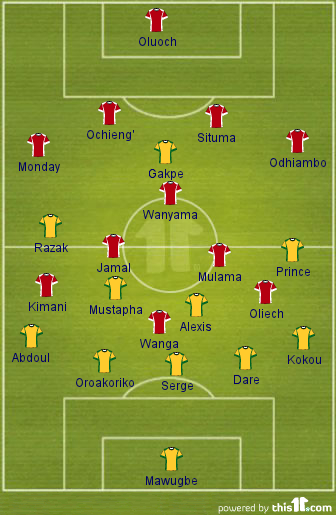The African Cup of Nations qualifiers for the tournament itself in 2013 kicked off this mid week. And in Nairobi, Kenya faced The Sparrow Hawks of Togo.
Both James Situma and Allan Wanga scored for Harambee Stars in a two one win over Togo.
This was a game of two teams with different strategies – one attacking and the other sitting deep and depending on quick balls.
STARTING XI
 |
| The Starting XI |
Francis Kimanzi started with Victor Wanyama in the holding midfield role, Jamal Muhammed and Titus Mulama ahead of him with MacDonald Mariga opting not to play.
In attack, Allan Wanga was the centre-forward with Dennis Oliech and Kevin Kimani the wide players.
Togo’s Didier Six played three centre-backs – Nigombe Dare, Akakpo Serge and Sedate Oroakoriko. And in the absence of Emmanuel Adebayor, Gakpe Serge was the lone forward.
KENYA’S FORMATION
Francis Kimanzi played his favoured 4-3-3 formation with the midfield three forming a triangle.
James Situma was beside Pascal Ochieng in central defense, Osborne Monday was the right full back and Dennis Odhiambo provided width on the left full back position. In the midfield, Victor Wanyama played the just ahead of the defense line with Titus Mulama and Jamal Mohammed in front of him. This provided an extra man in the midfield third against Togo’s two – 3v2.
In attack, Dennis Oliech started on the left wing and Kevin Kimani on the right. They occasionally swapped positions as the game progressed. Allan Wanga was the centre forward.
TOGO’S FORMATION
Didier Six was happy to see his team sit deep. He played with a 5-4-1 formation with the full backs moving forward to join in attack.
Nigombe Dare, Akakpo Serge and Sedate Oroakoriko were the three centre-backs and in full-back position, Donou Kokou was in the right and Maman Abdoul the left full back. Abdoul had the freedom to push high up when they had the ball and in the second half, he did cut in to the midfield – a rare movement though because Kenya had a greater share in terms of possession.
In central midfield, Ronao Alexis played just off Salifou Mustapha who was ahead of him. Right winger Segbefia Prince stretched the game wide with his excellent pace and trickery while on the left wing, Razak Boukari drifted in from wide areas. Gakpe Serge was left isolated in attack.
Though after they conceded the second goal, they played with a 5-3-2 formation when they had the ball and 5-4-1 without it. Segbefia Prince played off the substitute Guedje Cyrill and occasionally dropped back to midfield when they lost the ball.
Though after they conceded the second goal, they played with a 5-3-2 formation when they had the ball and 5-4-1 without it. Segbefia Prince played off the substitute Guedje Cyrill and occasionally dropped back to midfield when they lost the ball.
KENYA PLAYED WELL
Harambee Stars passed the ball brilliantly in the midfield with Wanyama sitting deep, Mulama and Jamal playing ahead of him with less defensive responsibilities, they linked up very well. Again with a 4-3-3 system, Kenya had an extra man in midfield. Though Boukari came infield, it was when Togo had the ball but when they lost it, he went back to his position.
And when Collins Okoth replaced Jamal, he moved deeper to join Wanyama, inverting the triangle with Mulama in the hole – or Humphrey Mieno who replaced Mulama later on.
TOGO SAT DEEP
The 5-4-1 formation says it all. Togo were happy to invite pressure from Kenya before breaking forward with quick balls – which rarely happened. The fullbacks didn’t move forward and this made the defense line very tight to break down. The centre forward, Serge was isolated in attack and didn’t provide much threat to Kenya’s defenders.
The 5-4-1 formation says it all. Togo were happy to invite pressure from Kenya before breaking forward with quick balls – which rarely happened. The fullbacks didn’t move forward and this made the defense line very tight to break down. The centre forward, Serge was isolated in attack and didn’t provide much threat to Kenya’s defenders.
They didn’t pose any major threat to Harambee Stars when it came to attacking.
CONCLUSION
The nature of how the goals were created – a set piece and poor clearance by their defender and scored their goal from a set piece - describes how defensive Togo were when in open play and how Togo were poor when it came to transition.
A deserving win for Kenya who played well the entire game.









